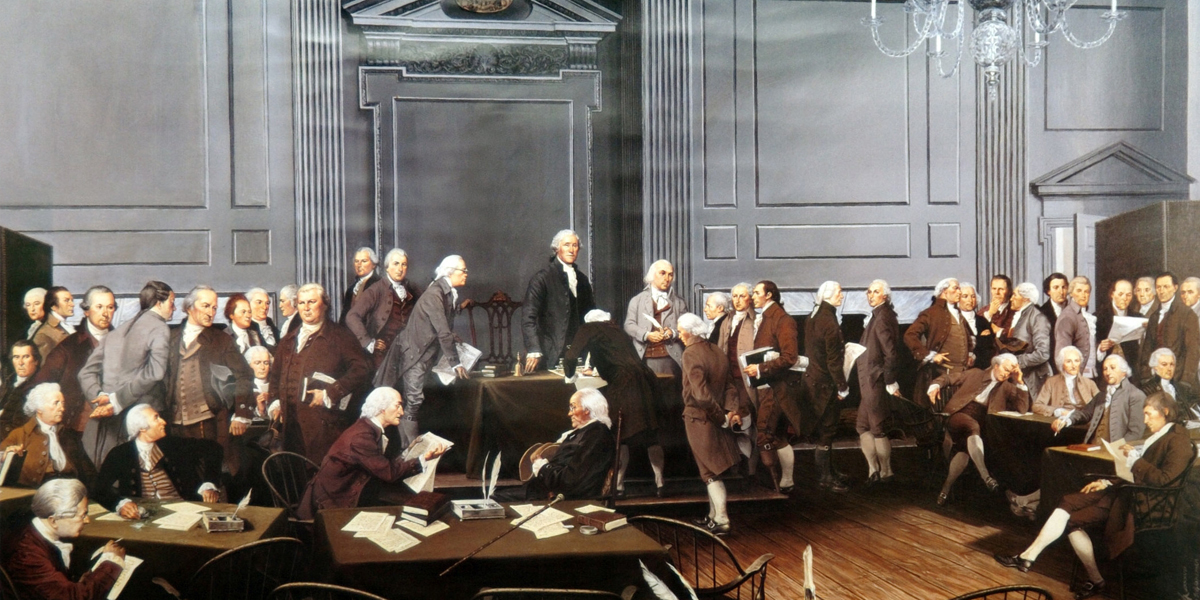
First Congress of the United States meets on March 04, 1789
United States First Day in Business: United States First Day in Business - The significance of March 4 predates the Constitution. The Confederation Congress, which operated under the Articles of Confederation (our first Constitution) picked March 4, 1789, as the day it handed off power to the new constitutional government
The first Congress convened in New York City. It was about one month before George Washington was elected at the first president under the new Constitution.
The new Congress quickly took care of an important task, when James Madison introduced the first draft Bill of Rights for consideration by its members.
However, neither the House or Senate had a quorum to vote. It would take another month for enough members to arrive in New York to start the 1st Congress. By September 1789, Congress had agreed on a version of the Bill of Rights to present to the states for ratification. That happened two years later.
Congress moved its first day of business after that to December 1, in accordance with Article I, Section 4, of the Constitution, which says that
“the Congress shall assemble at least once in every year, and such meeting shall be on the first Monday in December, unless they shall by law appoint a different day.””

The 3rd Congress started meeting on December 1, but March 4 was reserved for a special role in every Congress. It was picked as the last day of its two-year session. (The Constitution didn’t mandate an ending date for a Congress.)
Logistically, the arrangement created problems. After a November election, defeated Congress members would still need to serve in session from December 1 to March 4 of the following year, in a very extended “lame duck” session.
The same lame-duck Congress also had responsibilities under the Constitution for conducting any business related to the election of the president and vice president, if needed.
Likewise, a newly elected president was inaugurated on March 4 as a new Congress was seated. The combination of a lame-duck president and Congress could have serious implications. For example, after Abraham Lincoln’s election in 1860, lame-duck President James Buchanan and a divided Congress saw seven southern states leave the Union until Lincoln took over on March 4, 1861.
Lame-duck House sessions also elected Thomas Jefferson and John Quincy Adams as president in two races that were sent to the House in 1800 and 1824.
Another point of contention was the exact time on March 4 that a congressional session ended.
A spat in 1851 started by a senator from Mississippi, Jefferson Davis, led to a Senate resolution marking 11:59 a.m. on March 4 as the end of a Congress and 12 p.m. as the start of a new Congress. (The House, as a habit, didn’t meet on March 4 at the time.)
Before then, some people considered the stroke of Midnight on March 3 as the end of Congress’s two-year term.
The Senate’s website describes a regular scene where the Senate doorkeeper would move the minute hand on the chamber’s official clock as members debated about time.
The drama over March 4 every year ended when the 20th Amendment was ratified in 1933. Part of the amendment eliminated an extended lame-duck Congress. The new amendment set January 3 as the starting day of a new Congress and January 20 as inauguration day for the president. The previous congressional and presidential terms ended just before the new terms began.
But not to be forgotten are some other March 4 events, such as President Lincoln’s two inaugural addresses and President Franklin Roosevelt’s address in 1933. One infamous inaugural was on March 4, 1829, when President Andrew Jackson’s supporters stormed the White House and had to be lured away with the promise of free liquor.
Constitution Center.org / Wikipedia / New World Encyclopedia.org /
History House of Representatives.United States.gov / United States Senate.gov / History Channel /
Library Of Congress.gov / National Archives.gov / History Channel /
First Congress of the United States meets on March 04, 1789 (YouTube) 

Understanding Military Terminology
Neutral
(DOD) In combat and combat support operations, an identity applied to a track whose characteristics, behavior, origin, or nationality indicate that it is neither supporting nor opposing friendly forces.
See also Suspect; Unknown.
Joint Publications (JP 3-0) Joint Chiefs of Staff - Federation Of American Scientists
Neutrality
In international law, the attitude of impartiality during periods of war adopted by third states toward a belligerent and subsequently recognized by the belligerent, which creates rights and duties between the impartial states and the belligerent.
Joint Publications (JP 3-0) Joint Chiefs of Staff - Federation Of American Scientists
Neutralize
1. As pertains to military operations, to render ineffective or unusable.
2. To render enemy personnel or materiel incapable of interfering with a particular operation.
3. To render safe mines, bombs, missiles, and booby traps.
4. To make harmless anything contaminated with a chemical agent.
Joint Publications (JP 3-0) Joint Chiefs of Staff - Federation Of American Scientists

The Old Salt’s Corner
“The Rime of the Ancient Mariner”
ARGUMENT
How a Ship having passed the Line was driven by storms to the cold Country towards the South Pole; and how from thence she made her course to the tropical Latitude of the Great Pacific Ocean; and of the strange things that befell; and in what manner the Ancyent Marinere came back to his own Country.
PART I
An ancient Mariner meeteth three Gallants bidden to a wedding-feast, and detaineth one.
It is an ancient Mariner,
And he stoppeth one of three.
“By thy long beard and glittering eye,
Now wherefore stopp’st thou me?
The Bridegroom’s doors are opened wide,
And I am next of kin;
The guests are met, the feast is set:
May’st hear the merry din.”
He holds him with his skinny hand,
“There was a ship”, quoth he.
“Hold off! unhand me, grey-beard loon!”
Eftsoons his hand dropt he.
The Wedding-Guest is spell-bound by the eye of the old seafaring man, and constrained to hear his tale.
continued ...
~ Samuel Taylor Coleridge
(originally published in Lyrical Ballads, 1798)
Full Poem

“I’m Just Sayin”
“Unfortunately, a super-abundance of dreams is paid for by a growing potential for nightmares.”
“The point of living and of being an optimist is to be foolish enough to believe the best is yet to come.”
“It is our responsibilities,
not ourselves,
that we should take seriously.”
~ Sir Peter Ustinov

“Thought for the Day”
“My attitude has always been,
if you fall flat on your face,
at least you're moving forward.
All you have to do is get back up and try again.”
“Train people well enough
so they can leave.
Treat them well enough
so they don’t want to.”
~ Richard Branson

“What I Learned”
“The future is always beginning now.”
“Those who live in the past limit their future.”
“Your future is created by what you do today not tomorrow.”
~ Anonymous

Second Hand News: Articles from Week 10 - March 02, 2020 - March 08, 2020
 What Buttigieg's pre-Super Tuesday exit means for the Democratic primary field
• Protesters turn their backs on Bloomberg during 'Bloody Sunday' anniversary church service
• ‘He was challenging Hillary:’ Biden rips Sanders call for candidate with most delegates to win nomination
• Coronavirus makes it to Rhode Island as state announces first case
What Buttigieg's pre-Super Tuesday exit means for the Democratic primary field
• Protesters turn their backs on Bloomberg during 'Bloody Sunday' anniversary church service
• ‘He was challenging Hillary:’ Biden rips Sanders call for candidate with most delegates to win nomination
• Coronavirus makes it to Rhode Island as state announces first case
Pence tells the public it’s 'not necessary' to buy face masks amid coronavirus outbreak
• Federal appeals court blocks Trump policy ordering asylum-seekers to stay in Mexico
• Republicans ask administration how it will deal with rush of coronavirus victims to the border
MOST READ: U.S. signs Taliban deal to begin withdrawal and Afghan peace talks
• “Big Story:” Trump celebrates Republican capture of Kentucky House seat long held by Democrats
• “It’s a mess:” Republican challenger says Schiff has done nothing to fight homeless crisis in California district
• Devin Nunes: Subpoenas 'ready to go' for 'dirty cops' if Republicans win the House
Washington Examiner
 Worried families blast Washington nursing home where one man has died from coronavirus and 50 more are ill for 'not testing patients and ignoring phone calls'
Worried families blast Washington nursing home where one man has died from coronavirus and 50 more are ill for 'not testing patients and ignoring phone calls'
• Pete Buttigieg drops out of the presidential race after coming fourth in South Carolina as speculation mounts he will back Joe Biden who called him when the news broke
• Cancer-stricken civil rights warrior John Lewis is hoisted aloft by crowd at Bloody Sunday march in Selma after congregants turned their backs on Mike Bloomberg
• Bernie Sanders projected to take deep-red state of Texas in Super Tuesday while new poll shows the Democratic socialist head-to-head with Joe Biden in North Carolina
'I don't want this fat woman representing my company': Bombshell dossier claims Mike Bloomberg abused employee who now features in his campaign, called another woman 'dog face' and failed to sack editor who gave employees MASSAGES
• 'I'm 15 years older than Bernie!': Dick Van Dyke, 94, says Sanders, 78, is youthful at Los Angeles rally as Sarah Silverman calls the 2020 hopeful 'my kind of Jew'
• SNL host John Mulaney blasted for joking it would be 'interesting' if senators stabbed President Trump after comparing him to Julius Caesar
Mexican immigrant who was released by Chicago authorities despite ICE telling them not to 'went on to rape a three-year-old girl in a McDonald's bathroom as she cried "daddy, daddy"'
• Alarming videos show Iranians LICKING holy shrines in religious tradition as country's clerical hardliners refuse to close sites despite coronavirus outbreak
• North Korea fires two 'unidentified projectiles' into the sea as Kim Jong Un restarts test after coronavirus may have forced delays
Coffee shop worker, 25, running her FIRST ever marathon qualifies for the U.S. Olympic team after conquering an eating disorder and broken bones
Daily Mail UK
 After Poor Showing In South Carolina, ‘Mayor Pete’ Buttigieg Will Drop Out Of 2020 Race
• Elizabeth Warren’s Trail Of Tears Is Over
• Joe Biden Sweeps South Carolina In His First 2020 Primary Win
After Poor Showing In South Carolina, ‘Mayor Pete’ Buttigieg Will Drop Out Of 2020 Race
• Elizabeth Warren’s Trail Of Tears Is Over
• Joe Biden Sweeps South Carolina In His First 2020 Primary Win
Antisemite Ilhan Omar Stumps For Bernie Sanders In Virginia In Final Days Before Primary
• Media Charges Trump With Calling Coronavirus A ‘Hoax’. He Didn’t.
• Bloomberg Implies Voters In 2016 Were Wrong To Rebel Against ‘Intelligentsia’
MOST READ: How A Russian’s Grocery Store Trip In 1989 Exposed The Lie Of Socialism
• The Student Debt You Willingly Took On Is Not My Problem To Solve
• Viral TikTok Shows Teenage Girls Giggling While One Gets An Abortion
• Everything You Think You Know About Cuba Is A Lie
• John Bolton Admits Last-Minute Impeachment Leak Was A Publicity Stunt
The Federalist

Invisible Armies: An Epic History of Guerrilla Warfare from Ancient Times to the Present.
 2 of 4
2 of 4
 3 of 4
3 of 4
 4 of 4
4 of 4

How AIDS Emerged from an African Forest.
 2 of 4
2 of 4
 3 of 4
3 of 4
 4 of 4
4 of 4
 John Batchelor (02/20/2020)
John Batchelor (02/20/2020)
 CORRUPTION CHRONICLES: It Ain’t Over For Former FBI Deputy Director Andrew McCabe
CORRUPTION CHRONICLES: It Ain’t Over For Former FBI Deputy Director Andrew McCabe
“Investigating the Investigators:” New Clinton Email Revelations, “Whistleblower” and Soros Records
U.S., Soros-Funded Ukrainian HIV Charity Under Criminal Probe for Embezzlement
CIA Won’t Confirm or Deny Documented “Whistleblower” Records
Judicial Watch

Mr. Answer Man Please Tell Us: How Do Tsunamis Work?
Tsunamis have been wreaking havoc on the world's coastlines for centuries. Since 1850 alone, tsunamis have been responsible for taking 420,000 lives and causing billions of dollars in damage. How do these monster waves work?
DON'T CALL IT A TIDAL WAVE
Tsunamis have nothing to do with the wind-generated waves we're used to seeing, or the tides - they’re a set of ocean waves caused by the rapid displacement of water. Most commonly, this happens when large underwater earthquakes push up the seabed; the larger and shallower the earthquake, the bigger the potential tsunami. Once generated, the waves split: A distant tsunami travels out into the open ocean, while a local tsunami travels toward the nearby coast. The speed of the waves depends on the depth of the water, but typically, waves roll across the ocean at speeds between 400 and 500 mph.
It’s not only the method of generation that differentiates tsunamis from wind-generated waves. On average, wind waves have a crest-to-crest wavelength—the distance over which the wave’s shape repeats—of approximately 330 feet and a height of 6.6 feet. A deep ocean tsunami will have a wavelength of 120 miles and amplitude (the distance from the peak of the wave to its trough) of only about 3.3 feet. This is why tsunamis are difficult to detect in the open ocean.
As a tsunami approaches the shore, the wave compresses: Its speed and wavelength decrease while its amplitude grows enormously. Most waves arrive on-shore not as a huge wave but as a fast-moving tidal bore that floods the shoreline. However, if the trough of the wave arrives before the ridge, or peak, the sea will recede from the shore, exposing normally submerged areas, as the trough builds into a ridge. This can serve as a brief warning that a tsunami is about to occur.
Other causes of tsunamis include underwater landslides and explosions. Another type of wave, called a mega-tsunami, is caused by above-water landslides or glacier calving. The largest recorded mega-tsunami struck in Alaska’s Lituya Bay in 1958; an earthquake triggered a landslide that displaced so much water that the waves created were 470 feet taller than the Empire State Building.

MONITORING WAVES
Like earthquakes, tsunamis can’t be predicted - but that doesn’t mean scientists aren’t trying to figure out ways to warn people before the flooding starts. Using a system of buoys called DART (Deep-Ocean Assessment and Reporting of Tsunamis) researchers can monitor ocean wave height in real time. When an earthquake occurs that scientists believe is likely to trigger a tsunami, these strategically placed buoys send reports on sea level change back to tsunami warning centers. There, scientists use that data to create a model of the potential tsunami’s effects and decide whether to issue a warning or make populations evacuate.

LOCATION, LOCATION, LOCATION
Tsunamis are mostly generated by quakes that occur in subduction zones: areas where denser oceanic plates slide underneath lighter continental plates, causing vertical displacement of the seafloor and water column above it. The majority of the world's subduction zones are in the Pacific Ocean bordering Oceania, Asia, North America, and South America. This highly unsettled loop is nicknamed the “ring of fire” for its concentration of geologic upheavals.
Because the Atlantic Ocean has far fewer subduction zones than the Pacific, Atlantic tsunamis are rare, but possible. The most likely cause would be an earthquake creating a submarine landslide that would displace a huge volume of water and trigger the wave.
In 2001, geophysicists Steven N. Ward and Simon Day suggested that an Atlantic mega-tsunami could be generated by a massive landslide off La Palma, the most active volcano in the Canary Islands archipelago. The theory was based on modeling a number of worst-case scenarios, the authors said. Others have argued that the danger is overblown.
Earthweb.edu / Wikipedia / Encyclopedia Britannica /
Live Science / National Geographic / Quora /
How Tsunamis Work (YouTube) 

NAVSPEAK aka U.S. Navy Slang
Leading Airman/Seaman/Fireman: “Honorary”" title for an individual who cannot seem to make PO3 within the first six years of his enlistment.
Leave: Vacation time.
LES: Leave and Earning Statement. A monthly review print-out of one's pay record, time-in-service, amount of leave on the books, and other important record keeping information.
LHO: Large Heavy Object. Useless piece of machinery.
Liberty: Free time away from work or the ship, usually after working hours or in port. Differs from leave (see above) in that one must stay close to one's home station and it is generally much shorter.
Liberty Boat: Boat assigned to transfer sailors to and from their ship when in a port that requires the ship to drop anchor instead of pulling pierside. Trips to the beach are generally low key. Trips back to the ship in the wee hours of the night are usually very entertaining.
Liberty Hound: A sailor who conspires to or is able to take extra liberty, or who enjoys liberty more than anything else. Also sailor(s) who head for the quarterdeck immediately after “shift colors”.
Liberty Risk: A sailor who loves liberty a little too much, so much so that he puts himself in danger by drinking too much, getting into fights, or pissing off the locals. Such a sailor will likely be restricted to the ship at the next liberty port.
Wiktionary.org

Just for you MARINE
Landing Gear: Crossed rifles exposed on the rank insignia of Lance Corporals, Corporals, and Sergeants.
Land of the big PX: Used in reference to CONUS by Marines deployed overseas.
Lawn Dart: Pejorative for various aircraft, possibly from the lawn dart effect.
LBV: Load Bearing Vest, personal equipment used to keep the most commonly used items within easy reach utilizing the PALS, usually a component of MOLLE or ILBE.
LCPLIC: Lance Corporal in Charge. A salty Lance Corporal.
Leatherneck: Nickname for Marine, so named for legends stating that stiff leather collars were once worn to protect the throat from sword-blows (also thought that high stocks were worn for discipline, to keep Marines' heads high and straight). The dress blue uniform still bears a high stock collar today. Also, Leatherneck Magazine.
Wikipedia.org

Naval Aviation Squadron Nicknames
HSC-12 Helicopter Sea Combat (HSC) Squadron Twelve (Helicopter Anti-Submarine Squadron Twelve or HSC-12) - nicknamed the “Golden Falcons”
United States Navy - Naval Air Station - Naval Air Facility Atsugi, Japan: March 07, 1952 - present.

Where Did That Saying Come From?

“A problem shared is a problem halved:”
Meaning: The proverbial saying 'A problem shared is a problem halved' expresses the idea that, when in difficulties it is useful to talk to someone about them.
History: Unlike the similarly worded 'a penny saved is a penny earned', the proverb 'a problem shared is a problem halved' isn't especially old.
The first use of it that I can find in print is in the English newspaper The Morecambe Guardian, November 1931:
“If she is married she still has the same problem [money worries] - though it is a happier one for, after all, a problem shared is a problem halved, and, at least, she has someone with whom to talk matters over.”
The expression crossed the Atlantic and began to be used in the USA after WWII. The first example of it that I know of there is in the Muncie Evening Press, November 1854. This uses the longer form:
“A problem shared is a problem halved. A joy shared is a joy doubled.”
Phrases.org UK

Science & Technology

Could Venus have been habitable?
• Researchers build a quantum dot energy harvester
• Computer simulations show human ancestors would have had an easier time giving birth than modern women
• Evolution of learning is key to better artificial intelligence
• Unusual Type II supernova discovered in NGC 1068
• Jackdaws learn from each other about 'dangerous' humans
• Researchers find lead in turmeric
Phys.org / MedicalXpress / TechXplore

Bizarre News (we couldn’t make up stuff this good - real news story)
Long-Standing Problem of 'Golden Ratio' and Other Irrational Numbers Solved with 'Magical Simplicity'

Most people rarely deal with irrational numbers—it would be, well, irrational, as they run on forever, and representing them accurately requires an infinite amount of space. But irrational constants such as π and √2—numbers that cannot be reduced to a simple fraction—frequently crop up in science and engineering. These unwieldy numbers have plagued mathematicians since the ancient Greeks; indeed, legend has it that Hippasus was drowned for suggesting irrationals existed. Now, though, anearly 80-year-old quandary about how well they can be approximated has been solved.
Many people conceptualize irrational numbers by rounding them to fractions or decimals: estimating π as 3.14, which is equivalent to 157/50, leads to widespread celebration of Pi Day on March 14th. Yet a different approximation, 22/7, is easier to wrangle and closer to π. This prompts the question: Is there a limit to how simple and accurate these approximations can ever get? And can we choose a fraction in any form we want?
In 1941 physicist Richard Duffin and mathematician Albert Schaeffer proposed a simple rule to answer these questions. Consider a quest to approximate various irrational numbers. First, decide on how close the approximation should be for fractions of a particular denominator. (Remember, the “numerator” refers to the top of a fraction and the “denominator” the bottom. Here, all the fractions are fully simplified—so, for example, 2/4 does not count as having the denominator 4 because it simplifies to 1/2.) You might decide that simplified fractions of the form n/2 can approximate any irrational number whose true value falls within 1/10 of them—giving the approximation an “error” of 1/10. Fractions that look like n/10 are closer together on the number line than those with denominator 2, so you might limit the error in that case to only 1/100—those fractions can approximate anything within 1/100th of them.
Usually, larger denominators are associated with smaller errors. If this is true, and there are infinitely many denominators that one can use to approximate a number to within the corresponding error, then by increasing the denominator the approximation can be made better and better. Duffin and Schaeffer’s rule measures when this can be done based on the size of the errors.
If the chosen errors are small enough in aggregate, a randomly picked irrational number x will have only a limited number of good approximations: it might fall into the gaps between approximations with particular denominators. But if the errors are big enough, there will be infinitely many denominators that create a good approximating fraction. In this case, if the errors also shrink as the denominators get bigger, then you can choose an approximation that is as precise as you want.

“Unproved”
The upshot is that either you can approximate almost every number arbitrarily well, or almost none of them. “There’s a striking dichotomy”, says Dimitris Koukoulopoulos, a mathematician at the University of Montreal. Moreover, you can choose errors however you want, and as long as they are large enough in aggregate most numbers can be approximated infinitely many ways. This means that, by choosing some errors as zero, you can limit the approximations to specific types of fractions—for example, those with denominators that are powers of 10 only.
Although it seems logical that small errors make it harder to approximate numbers, Duffin and Schaeffer were unable to prove their conjecture—and neither was anybody else. The proof remained “a landmark open problem” in number theory, says Christoph Aistleitner, a mathematician at Graz University of Technology in Austria who has studied the problem. That is, until this summer, when Koukoulopoulos and his co-author James Maynard announced their solution in a paper posted to the preprint server arXiv.org.
The Duffin-Schaeffer conjecture “has this magical simplicity in an area of maths that’s normally exceptionally difficult and complicated,” Maynard says, a professor at the University of Oxford. He stumbled into the problem by accident—he is a number theorist, but not in the same area as most Duffin-Schaeffer experts. (He normally studies prime numbers — those that are divisible by only themselves and 1.) A University of York professor suggested Maynard tackle the Duffin-Schaeffer conjecture after he gave a talk there. “I think he had an intuition that it might be beneficial to get someone slightly outside of that immediate field,” says Maynard. That intuition turned out to be correct, although it would not bear fruit for several years. Long after that initial conversation, Maynard suggested a collaboration to Koukoulopoulos on a suspicion that his colleague had relevant expertise.
Maynard and Koukoulopoulos knew that previous work in the field had reduced the problem to one about the prime factors of the denominators—the prime numbers that, when multiplied together, yield the denominator. Maynard suggested thinking about the problem as shading in numbers: “Imagine, on the number line, coloring in all the numbers close to fractions with denominator 100”. The Duffin-Schaeffer conjecture says if the errors are large enough and one does this for every possible denominator, almost every number will be colored in infinitely many times.
For any particular denominator, only part of the number line will be colored in. If mathematicians could show that for each denominator, sufficiently different areas were colored, they would ensure almost every number was colored. If they could also prove those sections were overlapping, they could conclude that happened many times. One way of capturing this idea of different-but-overlapping areas is to prove the regions colored by different denominators had nothing to do with one another—they were independent.
But this is not actually true, especially if two denominators share many prime factors. For example, the possible denominators 10 and 100 share factors 2 and 5—and the numbers that can be approximated by fractions of the form n/10 exhibit frustrating overlaps with those that can be approximated by fractions n/100.

“Graphing the problem”
Maynard and Koukoulopoulos solved this conundrum by reframing the problem in terms of networks that mathematicians call graphs—a bunch of dots, with some connected by lines (called edges). The dots in their graphs represented possible denominators that the researchers wanted to use for the approximating fraction, and two dots were connected by an edge if they had many prime factors in common. The graphs had a lot of edges precisely in cases where the allowed denominators had unwanted dependencies.
Using graphs allowed the two mathematicians to visualize the problem in a new way. “One of the biggest insights you need is to forget all the unimportant parts of the problem and to just home in on the one or two factors that make [it] very special”, says Maynard. Using graphs, he says, “not only lets you prove the result, but it’s really telling you something structural about what’s going on in the problem”. Maynard and Koukoulopoulos deduced that graphs with many edges corresponded to a particular, highly structured mathematical situation that they could analyze separately.
It may take other experts several months to understand the full details. “The proof now is a long and complicated proof”, says Aistleitner. “It’s not sufficient just to have one striking, brilliant idea. There are many, many parts that have to be controlled.” At 44 pages of dense, technical mathematics, even leading mathematical minds need time to wrap their heads around the paper. The community, however, seems optimistic. Says Vaaler: “It’s a beautiful paper. I think it’s correct.”
• Scientific American
Live Science (08/30/2019) 


SONG FACTS

“God Only Knows” - The Beach Boys
Album: Pet Sounds
Released 1966 
Brian Wilson wrote “God Only Knows” with Tony Asher, who was an advertising copyrighter and lyricist that Wilson worked with on songs for Pet Sounds. This song reflects Wilson's interest in spirituality, and it was a big departure from previous Beach Boys songs that dealt with girls, cars and surfing. Wilson explained to Goldmine in 2011:
“Tony Asher and I tried to write something very spiritually. It's got a melody similar to the song (recites lyric to 'The Sound Of Music'  ), 'I hear the sound of music…' (Sings lyrics to 'God Only Knows') 'I may not always love you…' It was similar to it. Tony came up with the title 'God Only Knows'. I was scared they'd ban playing it on the radio because of the title but they didn't.”
), 'I hear the sound of music…' (Sings lyrics to 'God Only Knows') 'I may not always love you…' It was similar to it. Tony came up with the title 'God Only Knows'. I was scared they'd ban playing it on the radio because of the title but they didn't.”
This song is considered a Beach Boys classic, but it only managed to scrape the Top 40 in the United States. That's because it was released as a B-side, partly because of fear that radio stations would refuse to play a song with “God” in the title. In the liner notes to the reissued Pet Sounds album, Tony Asher explained:
“I really thought it was going to be everything it was, and yet we were taking some real chances with it. First of all, the lyric opens by saying, 'I may not always love you,' which is a very unusual way to start a love song.”
Carl Wilson handled lead vocals on this track. Not long after the song was released, he said:
“At present our influences are of a religious nature. Not any specific religion but an idea based upon that of Universal Consciousness. The concept of spreading goodwill, good thoughts and happiness is nothing new. It is an idea which religious teachers and philosophers have been handing down for centuries, but it is also our hope. The spiritual concept of happiness and doing good to others is extremely important to the lyric of our songs, and the religious element of some of the better church music is also contained within some of our new work.”
The Beatles' “Here, There And Everywhere”  was inspired by this song. John Lennon and Paul McCartney heard Pet Sounds at a party and went back to Lennon's house to write it. Paul McCartney once called “God Only Knows” “The greatest song ever written”.
was inspired by this song. John Lennon and Paul McCartney heard Pet Sounds at a party and went back to Lennon's house to write it. Paul McCartney once called “God Only Knows” “The greatest song ever written”.
The famous French horn on this song was played by Alan Robinson, who appeared on the scores for many films, including The Sound of Music and The Ten Commandments. He got the call for the session because he could play without music written out. Brian Wilson sang him the horn line he had in mind, and Robinson played it by ear using a glissando technique suggested by Wilson.
Brian Wilson would sometimes introduce this as “the first song in the world to have God in the title”. God is common in hymns and standards (“God Bless America”  , “Nearer, My God, to Thee”
, “Nearer, My God, to Thee”  ), and was rare in pop songs, but not unprecedented; in 1961 Johnny Burnette made #18 U.S. with “God, Country And My Baby”
), and was rare in pop songs, but not unprecedented; in 1961 Johnny Burnette made #18 U.S. with “God, Country And My Baby”  .
.
Brian Wilson planned to sing the lead vocal himself, but decided that his brother Carl was better suited for the track. “I was looking for a tenderness and a sweetness which I knew Carl had in himself as well as in his voice”, said Brian.
The Beach Boys official site / Rock & Roll Hall of Fame / Billboard / All Music / Song Facts / Ultimate Classic Rock / “Becoming The Beach Boys 1961 - 1963” / The Beach Boys
Image: “Pet Sounds (album)” by The Beach Boys

Trivia
● Before the Beatles formed their own record label, Apple Records, in 1968, they had most of their hits on one record label in Britain and a different label in the U.S. Can you name these two record labels?
Answer to Trivia
● What is the name of the John Philip Sousa march named after a famous newspaper?
Answer to Trivia
● In 1893, inspired by the view from atop Pikes Peak, Katharine Lee Bates, Massachusetts educator and author, wrote a song that begins, “O beautiful for spacious skies, for amber waves of grain.” What’s the title of that song?
Answer to Trivia
● Beethoven’s Piano Sonata in C Minor and Tchaikowski’s Symphony Number 6 both have the same sad-sounding name. What is this one word?
Answer to Trivia
● The key of C major can be played on a piano entirely on the white keys, needing no sharps or flats. What minor key can be played using the same all-white keys, with no sharps or flats?
Answer to Trivia

A Test for People Who Know Everything
From the Jeopardy Archives Category - “DITLOIDS” ($200)
“Weight for it: 16 O I A P.”
● Answer for People Who Do Not Know Everything, or Want to Verify Their Answer Ask Numbers
From the Jeopardy Archives Category - “DITLOIDS” ($400)
“Paid off Mr. Iscariot: 30 P O S.”
● Answer for People Who Do Not Know Everything, or Want to Verify Their Answer Quora
From the Jeopardy Archives Category - “DITLOIDS” ($600)
“They include a scale & a bull: 12 S O T Z.”
● Answer for People Who Do Not Know Everything, or Want to Verify Their Answer Astrology
From the Jeopardy Archives Category - “DITLOIDS” ($800)
“The talus is one: 206 B I T H B.”
● Answer for People Who Do Not Know Everything, or Want to Verify Their Answer Better Health Australia.vic.gov.au
From the Jeopardy Archives Category - “DITLOIDS” ($1,000) Triple Stumper
“The classic ditloid, a Solzhenitsyn novel: 1 D I T L O I D.”
● Answer for People Who Do Not Know Everything, or Want to Verify Their Answer Solzhenitsyn Center.org
Answer to Last Week's Test
From the Jeopardy Archives Category - “'X' IN THE CITY” ($200)
“It's home to Britain's oldest university.”
● Answer: “Oxford”. OX.ac.UK
From the Jeopardy Archives Category - “'X' IN THE CITY” ($400)
“This Nova Scotia capital is actually closer to Dublin, Ireland than it is to Victoria, British Columbia.”
● Answer: Halifax. Nova Scotia
From the Jeopardy Archives Category - “'X' IN THE CITY” ($600)
“Antony & Cleopatra died there in 30 B.C.”
● Answer: Alexandria. Ancient.EU
From the Jeopardy Archives Category - “'X' IN THE CITY” ($800)
“It's the state capital whose official flag is seen here.”
● Answer: Phoenix. State Symbols USA.org
From the Jeopardy Archives Category - “'X' IN THE CITY” ($1,000)
“It's the largest city in South Dakota & its X is silent.”
● Answer: Sioux Falls. Sioux Falls

Joke of the Day

“HEAVEN or HELL”
One night, God visits a preacher.
The preacher has one question, “What is Heaven like?“
God replies, “HEAVEN is like a city. It has the best of everything. For example:
the French are the chefs,
the Italians are the lovers,
the English are the policeman,
the Germans are the mechanics,
and the Dutch are the politicians.”
The preacher asks, “What is Hell like?“
“Well”, God sighs, “HELL is where:
the French are the mechanics,
the Italians are the politicians,
the English are the chefs,
the Germans are the policemen,
and the Dutch are the lovers.”

“An accountant dies and goes to Heaven”
An accountant dies and goes to Heaven. He is met by Saint Peter who goes through the usual questionnaire.
“What sort of accountant are you?” says Saint Peter
“Public Practitioner”, is the reply.
“Name?“
He gives his name.
Saint Peter goes through some files and pulls one out.
“Oh, yes. We've been expecting you. You've reached your allotted span”, says Saint Peter.
“How can that be?” says the accountant. “I'm too young to go. I'm only forty-eight.” “Why do you say that?”
“Well we've been looking at your time sheets and the hours you've charged your clients. By our reckoning you're at least ninety three.”

“An engineer dies and goes to Hell”
An engineer died and reported to the pearly gates.
An newly annointed angel, filling in for Saint Peter, checked his dossier and grimly said, “Ah, you're an engineer; you're in the wrong place.”
So the engineer was cast down to the gates of hell and was let in.
Pretty soon, the engineer became gravely dissatisfied with the level of comfort in hell, and began designing and building improvements.
After a while, the underworld had air conditioning, flush toilets, and escalators, and the engineer was becoming a pretty popular guy among the demons.
One day, God called Satan up on the telephone and asked with a sneer, “So, how's it going down there in hell?”
Satan laughed and replied, “Hey, things are going great. We've got air conditioning and flush toilets and escalators, and there's no telling what this engineer is going to come up with next.”
God's face clouded over and he exploded, “What? You've got an engineer? That's a mistake; he should never have gotten down there; send him up here.”
Satan shook his head, “No way. I like having an engineer on the staff, and I'm keeping him.”
God was as mad as he had ever been, “This is not the way things are supposed to work and you know it. Send him back up here or I'll sue.”
Satan laughed uproariously, “Yeah, right. And just where are YOU going to get a lawyer?”






































